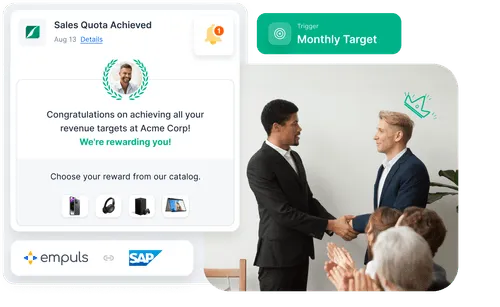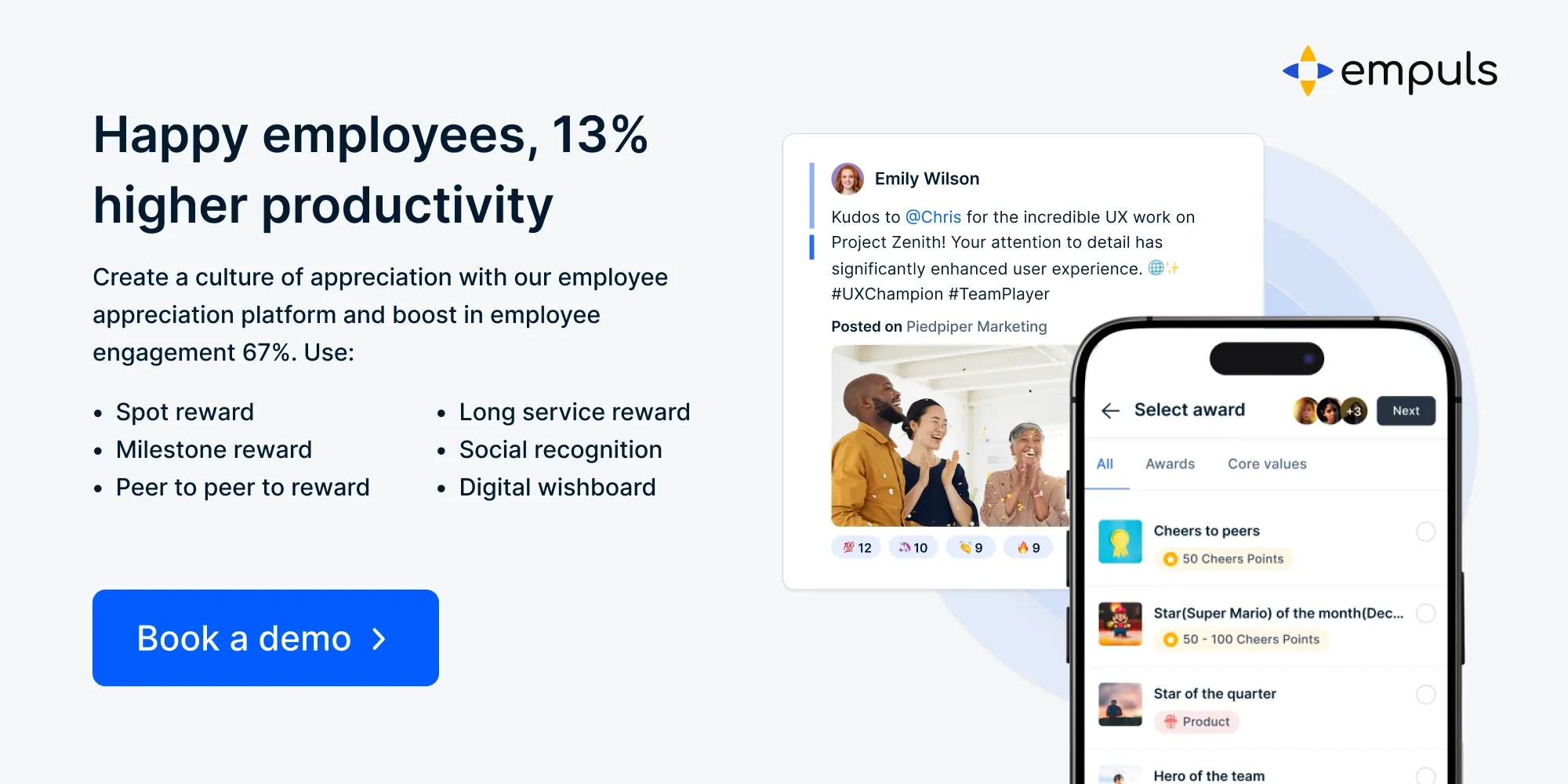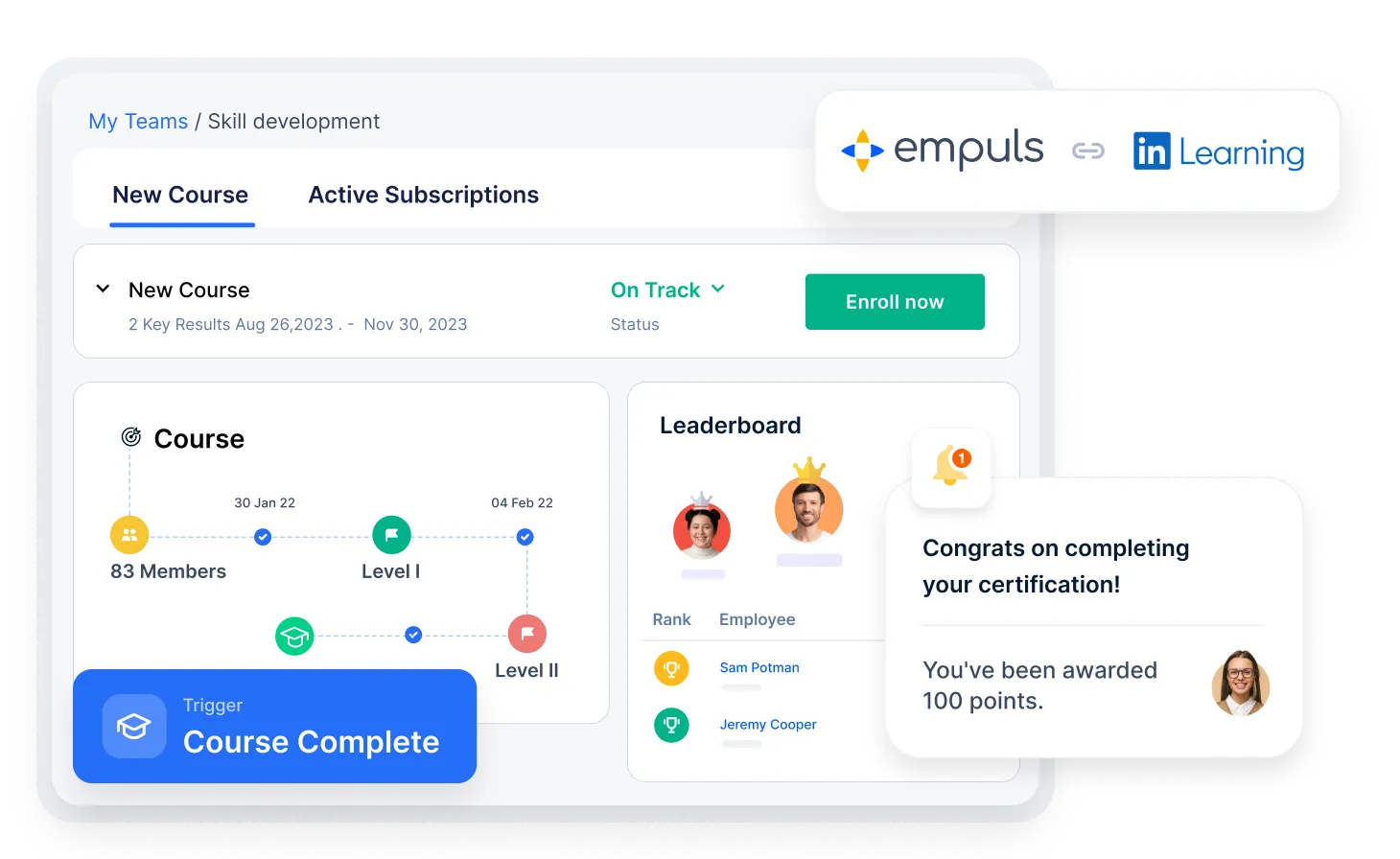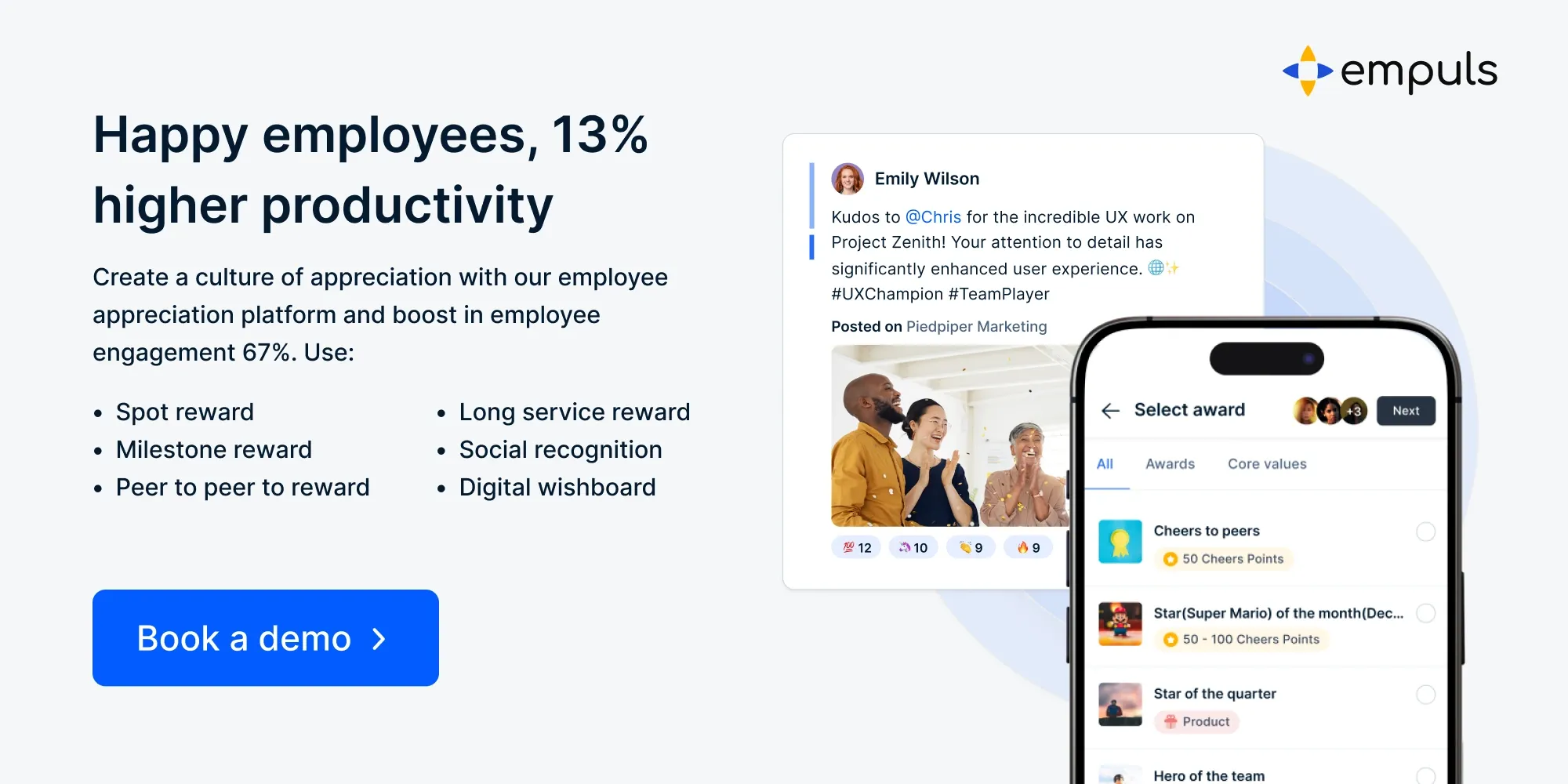30 Employee Incentive Programs to Consider Running in 2025 for Better Engagement
Discover 30 effective employee incentive programs to enhance engagement and performance. Explore strategies for remote teams and measure your program's success.
On this page
Disengagement among employees is a pressing issue that leads to high turnover rates, reduced productivity, and significant financial losses. In fact, unhappy employees cost the U.S. economy an astounding $1.9 billion annually. This highlights the critical need for effective employee rewards programs.
Employee incentive programs are powerful tools to reignite engagement and enthusiasm in the workplace. A well-designed recognition program can increase productivity by up to 44%.
However, choosing the right incentive program for employees can be challenging with so many options available. In this guide, we will explore 30 examples of effective employee incentive programs and share practical tips to ensure their success.
What is an employee incentive program?
An employee incentive program is a reward system designed to motivate employees and enhance their performance. Some of the most popular employee incentive programs include leadership training & development, monetary rewards, non-monetary rewards, team-building activities, office/workplace swag bags, bonus payouts, recognition awards, perks & discounts programs, etc.
Effective employee incentive programs aim to recognize and reward employees for their achievements, fostering a positive work environment. If an employee incentive program is implemented, an organization may notice:
- A boost in employee engagement and morale.
- By offering monetary rewards, such as cash incentives or stock ownership plans, companies can motivate employees to excel in their roles.
- These programs encourage team members to actively participate in achieving company goals, leading to improved job satisfaction and higher retention rates.
When employees feel valued through recognition programs and financial incentives, it enhances their overall experience and promotes a culture of loyalty, ultimately benefiting the organization’s success. Let’s take a look at what the stats are showing:
Gallup's research shows that 74% of employees who are incentivized strongly agree that their work feels valuable and meaningful.
-> IRF study has revealed that 84% of U.S. businesses invest in award points, gift cards, trips, merchandise, and experiential rewards, collectively spending $176 billion annually to reward sales staff, employees.
-> The same study shared that in North America, there's a net increase of 37% in budgets for merchandise, gift cards, and event gifting. Growth is projected through 2025 for both the number of participants in incentive trips and per-person spending.
-> An HBR study showed that having a happier sales team with incentives can boost sales by up to 37%.
-> A SHRM study state that companies with an incentive program see 52% higher employee productivity.
-> Shockingly, only 33% of employees feel engaged and valued at their workplace, relating directly to incentives, according to Gallup.
These insights underscore the critical role of employee appreciation and incentives in today's business landscape, emphasizing their value in motivating and retaining employees.
Employee incentives vs employee rewards
Employee incentives are specific programs designed to motivate employees to achieve certain goals, often linked to performance metrics. Examples include monetary bonuses, profit sharing, and tuition reimbursement.
On the other hand, employee rewards are recognitions or benefits given for achievements, such as cash rewards, health insurance, or wellness programs, aimed at appreciating employees’ contributions.
How do incentive programs impact employee performance and engagement?
Incentives play a crucial role in enhancing employee performance and engagement. They serve as external motivators that encourage specific behaviors aligned with organizational goals.
- Incentive programs enhance performance: Well-structured incentive programs can boost employee performance by 22% on average, with team incentives potentially increasing performance by up to 44%.
- Impact on engagement and satisfaction: Employees who feel recognized and valued are likelier to be engaged. A survey indicated that 79% of employees would work harder if their efforts were better acknowledged and incentivized.
- Financial incentives drive motivation: Financial rewards, such as bonuses and performance-based pay, significantly enhance job satisfaction and motivation. These incentives align personal goals with organizational objectives, encouraging employees to strive for higher job performance.
- Long-term engagement requires holistic approaches: While incentives are crucial, they should be part of a broader strategy that includes a positive work culture and opportunities for growth. Engaged companies see 22% higher customer loyalty and 65% lower turnover.
- Customizing incentives for effectiveness: The success of incentive programs depends on their design and implementation. Tailoring incentives to fit employees' needs and motivations can lead to better outcomes.
- Consequences of poor incentive structures: Ineffective incentive programs can lead to disengagement, burnout, and "quiet quitting," highlighting the need for thoughtful program development.
These insights underscore the significant role that well-designed employee incentive programs play in enhancing employee performance and engagement.
Using Empuls, SPI Cinemas digitized its engagement program. This enabled their employees to gain instant access to the milestones they needed to achieve, after which the system automatically awarded them points redeemable at Xoxoday's Stores portal (catalog).
The attrition reduced from 8% to 4.5% after implementing Empuls, the employee engagement platform, cultivating a culture of recognition, free flow of information, and a transparent rewards system.
20 employee incentive programs ideas for a motivated workforce
These 20 employee incentive programs help boost motivation, improve retention, and create a workplace where employees feel valued. Choosing the right mix of rewards ensures long-term engagement and productivity.
1. Achievement recognition program
This program focuses on recognizing employees who meet or exceed their performance goals. It includes monthly awards, such as plaques or certificates, along with public acknowledgment during team meetings. By celebrating achievements, this program boosts employee morale and encourages a culture of excellence.
2. Wellness rewards program
Aimed at promoting healthy lifestyles, this program offers incentives for participating in wellness activities, such as gym memberships or fitness challenges. Employees can earn points for completing wellness-related tasks, which can be redeemed for rewards like gift cards or extra time off. This not only improves employee health but also enhances overall job satisfaction.
Encourage a healthier, more engaged workforce with Empuls. Reward employees for wellness activities with redeemable points, gift cards, and extra time off—all in one seamless platform.
3. Professional development program
This initiative supports employees in pursuing further education and skill development through tuition reimbursement and access to online courses. Employees are encouraged to set professional goals, and the company provides financial assistance for relevant training programs. This investment in employee growth fosters loyalty and engagement.
4. Profit-sharing plan
In this program, employees receive a share of the company's profits based on its financial performance. This financial employee incentive aligns employees' interests with the company's success, motivating them to contribute to achieving business goals. It enhances employee retention by making them feel like integral parts of the organization.
5. Employee stock ownership plan (ESOP)
An ESOP allows employees to acquire shares in the company, fostering a sense of ownership and commitment. As employees see the direct impact of their work on company performance, they are motivated to enhance productivity and collaboration. This program can significantly boost employee loyalty and satisfaction.
6. Referral bonus program
This program incentivizes current employees to refer qualified candidates for open positions within the company. Employees receive a monetary reward if their referral is hired and stays with the company for a specified period. This not only helps attract top talent but also reinforces a sense of community among team members.
7. Team performance incentives
Under this program, teams that achieve specific goals or exceed targets are rewarded collectively with bonuses or team outings. This encourages collaboration and teamwork while fostering a sense of camaraderie among team members. Such employee incentives in the incentive program boost overall engagement and employees motivation.
8. Flexible work arrangements program
This initiative allows employees to choose their work hours or remote work options based on their personal needs. By offering flexibility, companies can enhance work-life balance and job satisfaction among employees. This program recognizes that diverse employee needs contribute to a more productive workforce.
9. Spot bonus program
A spot bonus program provides immediate recognition and rewards for exceptional performance or contributions that go above and beyond expectations. Managers can issue these bonuses at any time, making them timely and relevant. This approach encourages ongoing high performance and reinforces positive behaviors in real-time.
10. Public recognition program
This program focuses on publicly acknowledging employee achievements through newsletters, social media shout-outs, or recognition boards in the workplace. Such visibility not only boosts morale but also encourages others to strive for similar recognition, creating a culture of appreciation within the organization.
11. Cash rewards for sales targets
In this incentive program, employees who meet or exceed sales targets receive cash bonuses as recognition for their efforts. This direct financial incentive motivates sales teams to push their limits while aligning their efforts with company goals, ultimately driving business success.
With enticing rewards and incentives via Empuls, organizations can motivate sales professionals to excel, fostering a culture of achievement and driving sustained business success.

12. Employee of the month program
Recognizing an "Employee of the Month" fosters healthy competition among team members while highlighting individual contributions to the organization’s success. The selected employee receives a plaque, a reserved parking spot, or other perks that enhance their status within the company.
13. Volunteer time off (VTO) program
This unique incentive allows employees to take paid time off to volunteer for causes they care about. By encouraging community involvement, companies not only support charitable initiatives but also enhance employee satisfaction and engagement through meaningful experiences outside of work.
14. Family-friendly benefits incentive program
Offering benefits such as parental leave, childcare assistance, or family health insurance options demonstrates an organization's commitment to supporting employees' family needs. These incentives help retaining employees and talent by creating an inclusive workplace where employees feel valued both personally and professionally.
15. Annual retreat or conference sponsorships
Sponsoring attendance at industry conferences or organizing annual retreats provides opportunities for networking and learning outside the office environment. Employees appreciate these experiences as they contribute to professional growth while enhancing team bonding through shared experiences.
16. In-house mentorship program
Pairing experienced employees with newer team members fosters knowledge sharing and professional development within the organization. Mentorship programs create a supportive environment where employees feel valued and encouraged to grow in their careers while enhancing overall employee engagement.
17. Health insurance premium discounts
Offering discounts on health insurance premiums for participating in wellness programs incentivizes healthy behavior among employees while reducing costs for both parties involved. Such financial incentives in the incentive program encourage individuals to prioritize their well-being while feeling supported by their employer’s initiatives.
18. Creative project funding program
Allowing employees to propose creative projects related to their roles—and providing funding for those initiatives—encourages innovation within the workplace environment. Employees feel empowered when they have opportunities to pursue ideas that align with company goals while showcasing their talents.
19. Skill-sharing workshops
Organizing workshops where employees can share their skills fosters collaboration while promoting continuous learning within teams. These sessions create an inclusive atmosphere where everyone has something valuable to contribute, enhancing overall employee satisfaction.
20. Feedback-driven improvement initiatives
Implementing regular feedback sessions allows employees’ voices to be heard regarding potential improvements within existing programs. By actively gathering input from staff members, organizations demonstrate that they value opinions, leading to increased trust, loyalty, and engagement among team members.

10 Employee incentive programs for remote employees
These 10 employee incentive programs for remote employees help keep teams motivated, connected, and engaged. Offering meaningful rewards and recognition ensures productivity and job satisfaction, no matter where employees work.
1. Remote work appreciation days
Designating specific days where remote workers are celebrated with virtual events or special gifts helps boost morale among those working from home. These appreciation days reinforce connections between remote teams while showing gratitude for their contributions.
2. Learning stipends
Providing stipends specifically for online courses or professional development resources encourages remote employees to enhance their skills at home. This investment reflects an organization's commitment towards continuous learning, fostering loyalty among team members.
Whether completing a training module, acquiring a new certification, or mastering a challenging skill, incentivize and motivate your employees to invest in their professional and personal development with Empuls.

3. Home office enhancement grants
Offering grants for improving home office setups allows remote workers to create comfortable work environments tailored to their needs. Such financial support demonstrates that employers care about employee well-being, leading to increased productivity levels.
4. Monthly virtual coffee chats with leadership
Organizing informal virtual coffee chats between leadership teams and remote staff fosters open communication channels. These sessions allow employees to share ideas directly with decision-makers while feeling valued as part of the organization’s culture.
5. Recognition through digital platforms
Utilizing online platforms dedicated solely to recognizing achievements creates an inclusive environment where remote workers feel appreciated. Regularly highlighting accomplishments boosts morale while encouraging others across dispersed teams.
Make every employee feel valued, no matter where they work. Empuls helps you foster a culture of appreciation with seamless, engaging recognition.
6. Flexible scheduling options for remote roles
Allowing flexibility in working hours empowers remote workers by accommodating personal commitments without sacrificing productivity. Organizations benefit from increased job satisfaction levels resulting from enhanced work-life balance opportunities.
7. Team-building activities via video conferencing tools
Scheduling regular virtual team-building activities encourages collaboration among remote colleagues who may otherwise feel isolated. Fun games or challenges foster camaraderie while strengthening relationships across geographically dispersed teams.
8. Health & wellness challenges tailored for remote workers
Implementing health challenges specifically designed for those working remotely promotes healthy habits while building camaraderie among participants. Incentives like gift cards in the incentive program can be awarded based on participation levels, encouraging active involvement across all staff members.
9. Personalized thank-you notes from management
Sending handwritten thank-you notes expressing appreciation towards individual contributions creates meaningful connections even when working remotely. Such gestures reinforce feelings of value within an organization’s culture, enhancing overall job satisfaction.
10. Collaborative relationships
Establishing a mentorship pairing system connecting experienced mentors with remote staff fosters knowledge sharing while providing professional development opportunities. This initiative supports career growth while building strong collaborative relationships despite physical distances.
How to start an employee incentive program?
A well-structured employee incentive program not only motivates employees but also strengthens workplace culture, improves retention, and enhances overall productivity. However, simply offering rewards isn't enough—success depends on careful planning and execution. Here’s how to create a program that truly drives impact.
1. Define your goals and metrics
Before launching an incentive program, determine what you want to achieve. Whether it's boosting productivity, increasing retention, improving employee engagement, or fostering teamwork, having clear, measurable objectives ensures the program aligns with business goals.
Metrics such as performance improvements, participation rates, and employee satisfaction scores help track success and make adjustments where needed.
2. Choose incentives that matter
The right incentives make all the difference. While monetary rewards like bonuses and salary hikes are effective, employees also value non-monetary incentives such as career growth opportunities, wellness benefits, and public recognition.
A mix of personalized and flexible rewards works best. Platforms like Empuls' rewards and recognition enable businesses to offer diverse incentives, including gift cards, experiences, and perks tailored to individual employee preferences.
3. Establish clear and fair criteria
Employees need to understand how they can earn rewards to stay motivated. Ambiguity or favoritism can demotivate employees instead of inspiring them. Define criteria that are objective, transparent, and inclusive—whether based on performance, behavior, innovation, or teamwork.
Ensuring a balance between individual and team-based rewards prevents unhealthy competition and encourages collaboration.
4. Automate and streamline incentive distribution
Managing incentives manually is time-consuming and prone to errors. Automating the process saves time, ensures fairness, and enhances the overall experience for employees.
Using a digital rewards platform simplifies tracking, managing, and distributing incentives. Employees can redeem rewards effortlessly, and HR teams can monitor participation and effectiveness without administrative burdens.
5. Foster continuous recognition with Empuls
An incentive program is most effective when it’s consistent and embedded into daily workflows rather than a one-time initiative. Instead of recognizing employees only during annual reviews or monthly meetings, foster continuous recognition to maintain engagement.
With Empuls, organizations can integrate recognition into daily work life, allowing managers and peers to instantly appreciate achievements through social feeds, digital badges, and leaderboards. Regular, small wins create a culture where employees feel valued every day.
6. Collect feedback and improve the program
Employee incentive programs should evolve based on feedback and real-world impact. Regularly survey employees to understand what works and what doesn’t. Are the incentives meaningful? Is the process fair? Are employees motivated?
Using tools like Empuls, organizations can conduct employee sentiment surveys and gather real-time insights to refine their programs. An adaptive approach ensures incentives remain relevant, driving long-term engagement and motivation.
Best practices for creating a strong employee incentive program
Following these best practices for creating a strong employee incentive program ensures rewards are meaningful, fair, and motivating. A well-structured program drives engagement, boosts retention, and fosters a culture of appreciation.
1. Begin with business goals
Align your incentive program with specific company goals, such as increasing employee engagement or exceeding sales targets. Track these goals and ensure the program remains focused.
2. Keep it simple but challenging
Design incentive programs that are easy to understand yet challenging enough to motivate employees. Use a user-friendly interface that makes it straightforward for team members to see their progress and rewards.
3. Link pay to performance, not profit
Focus on rewarding employees based on their individual performance rather than overall company profits. Allow for customizable metrics to assess employee contributions effectively.
4. Keep it fair
Establish clear guidelines to ensure fairness in how rewards are distributed. Facilitate transparency, helping employees feel valued and reducing perceptions of favoritism.
5. Reward employees with what they truly want
Identify desirable incentives for the incentive programs—like cash bonuses, gift cards, or professional development opportunities—that resonate with your workforce. Empuls provides insights into employee preferences to tailor rewards effectively.
6. Integrate flexibility
Create a program that can adapt during tough economic times while still recognizing high performers. Empuls supports flexible reward options, ensuring continuous motivation even during challenges. Integrate within your workspace for maximum flexibility.
By implementing these best practices with tools like Empuls, organizations can develop effective employee incentive programs that enhance morale, engagement, and overall job satisfaction.

Key takeaways
Implementing robust and diverse employee incentive programs is essential for organizations aiming to boost engagement, reduce turnover, and enhance overall productivity. In this content, we learned:
- Monetary rewards for individual contributions that enhance motivation and engagement.
- Celebrating achievements boosts morale and fosters a supportive work environment.
- A variety of innovative incentive programs, such as achievement recognition, wellness rewards, profit-sharing, and flexible work arrangements, can cater to diverse employee motivations.
- Tailoring incentive programs to meet the unique needs and preferences of employees is crucial for maximizing engagement and fostering a positive workplace culture.
Empuls allows businesses to tailor monetary incentives and non-monetary rewards that resonate with their team members, helping to motivate employees and improve employee morale.
Through features like profit sharing, cash bonuses, and gift cards, Empuls ensures that employees are recognized for exceeding sales targets and achieving key performance indicators. This not only enhances job satisfaction but also promotes employee retention and loyalty, ultimately driving business success.
- Empuls offers a diverse range of rewards, allowing employees to select incentives that resonate with them personally. This includes options from an extensive catalog of over 20,000 rewards, including products from major retailers like Amazon.
- The system automates the distribution of rewards and recognition, ensuring that no significant milestones are overlooked.
- Empuls allows for customizable workflows that include approval processes for nominations and awards, which helps maintain transparency and fairness in recognition.
- By integrating recognition into everyday tasks and celebrating achievements publicly within the organization, Empuls helps cultivate a positive work environment.
- The platform also contributes to improved employee satisfaction and retention rates by making employees feel valued through consistent recognition of their contributions.
By actively participating in Empuls's programs, organizations can create an inclusive company culture that prioritizes professional development opportunities and encourages healthy habits, ensuring that every employee feels engaged and motivated to contribute to the company's goals. Schedule a call now!
FAQs
1. What is the employee recruitment incentive program?
An employee recruitment incentive program is a strategic approach businesses use to attract new talent. It offers incentives such as sign-on bonuses, flexible hours, and professional development opportunities to entice potential candidates.
By actively participating in these programs, companies demonstrate their commitment to being an inclusive employer and fostering a positive company culture. These programs also boost employee engagement among team members and ensure employees feel valued from the outset.
2. What is an example of an employee incentive plan?
An example of an employee incentive plan is a profit-sharing program, where employees receive a percentage of the company's profits. This type of financial reward incentivizes employees to contribute to the company's success.
Another example is offering cash rewards or gift cards to team members who meet or exceed sales targets. Both monetary and non-monetary incentive program like public recognition or professional development opportunities encourage employees and strengthen their loyalty to the company.
3. What are the 4 examples of incentives?
- Monetary Incentives: Cash bonuses, financial rewards, and profit-sharing programs.
- Non-Monetary Incentives: Flexible hours, tuition reimbursement, and professional development opportunities.
- Team Incentives: Team rewards for exceeding sales targets or achieving milestones.
- Employee Benefits: Health insurance, employee stock ownership plans, and wellness programs.
4. What is an example of a work incentive plan?
A comprehensive employee incentive programs work plan could include monetary bonuses for individual achievements, team rewards for collaborative efforts, and non-monetary incentives like public recognition or wellness programs.
For instance, an organization may incentivize employees by offering cash rewards for achieving sales targets while also recognizing their efforts with public accolades. This combination ensures employees feel appreciated and boosts employee engagement.


















